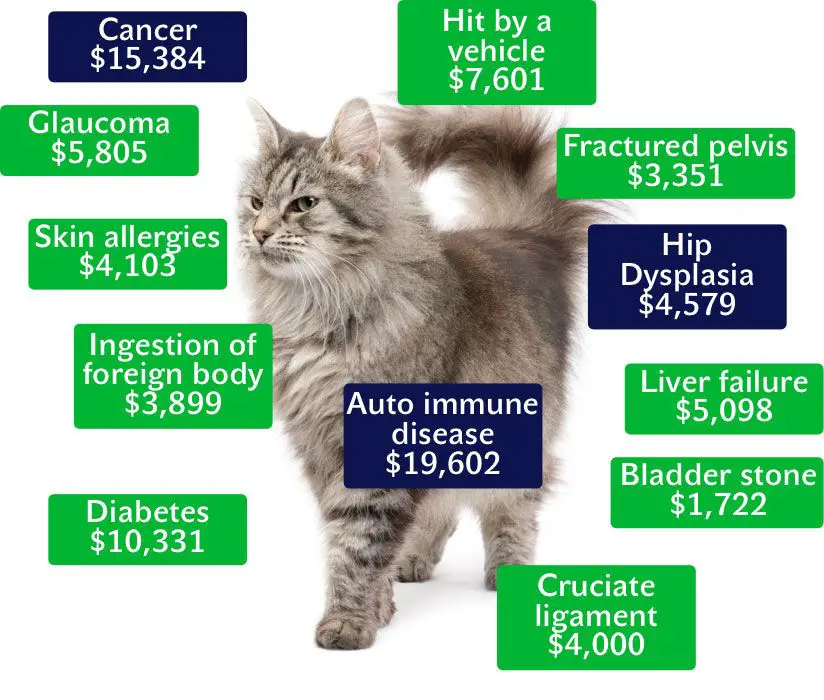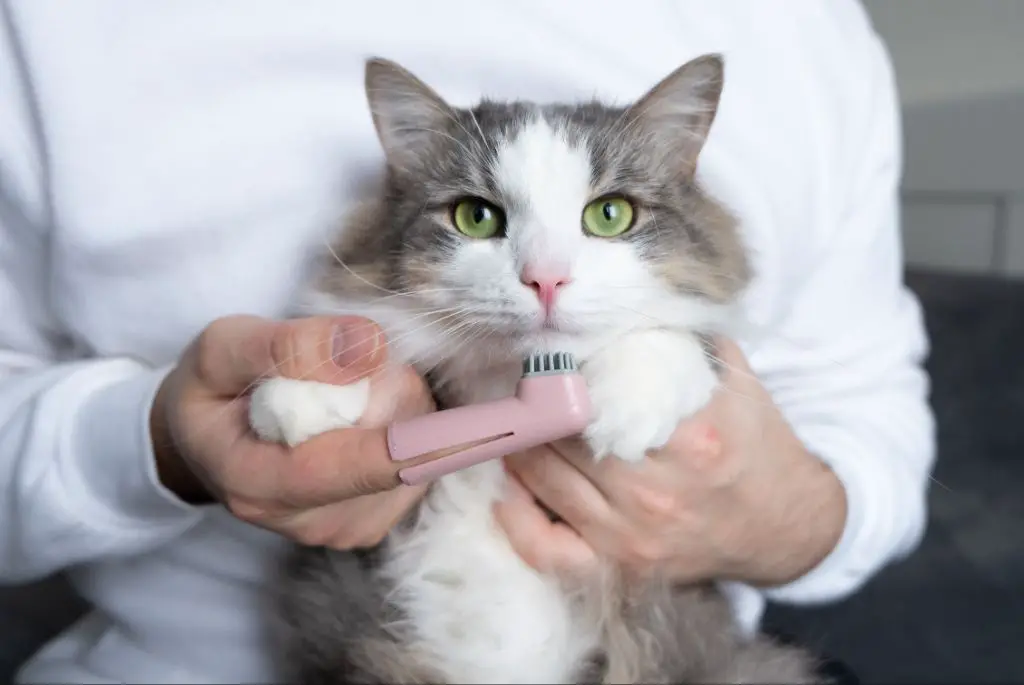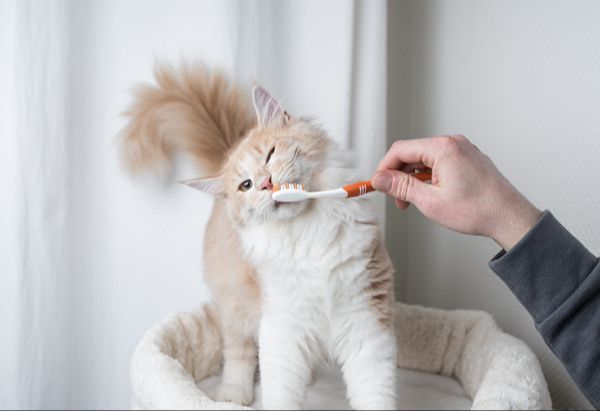Dental care is extremely important for cats, as dental disease is the most common medical issue seen in adult cats. Unfortunately, dental cleanings and treatments can become quite costly. This is where cat dental insurance comes in – it can help offset some of the costs associated with dental care. In this article, we’ll provide an overview of what procedures and services cat dental insurance typically covers, any limitations, and tips for comparing plans and their dental benefits.
Common Dental Issues for Cats
Cats can face a variety of dental problems, with some of the most common being gum disease, tooth decay, and tooth resorption. Gum disease, also known as periodontal disease, occurs when plaque builds up on the teeth and leads to inflammation and infection of the gums and tissue around the teeth. If left untreated, it can lead to tooth loss. Early signs of gum disease include red, swollen, or bleeding gums. According to Cornell University, by age 3, most cats have some form of gum disease.
Tooth decay is another common problem, causing erosion and cavities, especially in older cats. It’s caused by the bacteria in plaque producing acids that attack the tooth enamel. Signs of tooth decay include brown spots or pits on the teeth or tooth fractures. Resorptive lesions are also common in cats, which are holes forming in the tooth from the inside out, often requiring extraction.
Regular dental cleanings and exams are important for identifying and treating these common dental diseases early before they lead to more severe issues. Owners should watch for signs of dental problems in their cats and discuss annual cleanings with their veterinarian.
Importance of Dental Care
Dental health is extremely important for cats. According to this article, dental disease is the most common medical issue diagnosed in cats. Plaque and tartar buildup can lead to painful infections and tooth decay. Poor dental hygiene has also been linked to issues in other parts of the body such as the heart, liver, and kidneys. Proper dental care, such as annual cleanings and daily brushing, can help prevent these problems. As explained by this source, establishing good dental habits early in a cat’s life is vital for their health and happiness later on. With regular dental maintenance, cats can avoid negative side effects and live longer, healthier lives overall.
Cost of Dental Procedures
Dental procedures for cats can range greatly in price depending on the extent of the work needed. According to Pawlicy.com https://www.pawlicy.com/blog/cat-dental-cleaning-cost/, a basic dental cleaning typically costs $100 to $400. However, more involved procedures like extractions can raise the price to $800 or more. Forbes Advisor https://www.forbes.com/advisor/pet-insurance/pet-care/cat-dental-cleaning-cost/ notes that cat dental cleanings can range from a few hundred dollars to over $2,000 depending on the extent of tartar buildup and necessary extractions.
Some typical costs for common dental procedures include:
- Routine cleaning: $200 – $400
- Tooth extraction: $50 – $100 per tooth
- Root canal: $800 – $1,200
- Crown: $900 – $1,100
Location and individual vet clinic fees also impact the total cost. But in general, cat owners can expect to spend several hundred dollars for a basic cleaning, and over $1,000 or more for procedures involving extractions or advanced dental work.
What Cat Insurance Typically Covers

In general, most cat insurance plans cover emergency veterinary care, surgeries, prescriptions, x-rays, bloodwork, and hospital stays. This usually includes unexpected illnesses, injuries from accidents, cancer treatments, tooth extractions, and chronic conditions (source). Depending on the policy, coverage may extend to annual vet visits, vaccines, diagnostic tests, and medications like flea, tick and heartworm preventatives (source).
Though policies vary, standard vet bills that cat insurance often reimburses include fees for the examination, consultation, diagnostics, anesthesia, surgery, hospitalization, prescription medications and more. For example, if your cat breaks a leg and needs x-rays, surgery and follow up appointments, your insurance would cover all or a portion of these expenses (source). Some insurance companies pay the vet directly, while others reimburse the owner after paying the vet bill.
In short, cat insurance is designed to help offset the costs of any necessary medical treatments your cat needs, providing reimbursement for vet services in illness and injury cases. However, maximum benefits and policy limitations apply.
Dental Coverage in Cat Insurance
Most cat insurance plans provide some level of dental coverage, but the extent of coverage varies between providers and policies. Some plans only cover dental treatments related to injuries and accidents, excluding conditions like gingivitis, abscesses, and tooth decay. Other more comprehensive plans will cover both dental illnesses and accidents. Typical procedures covered include tooth extractions, x-rays, root canals, crowns, and more.

According to the ASPCA, dental coverage is one of the most common add-ons for cat insurance plans [1]. Many insurance providers like Healthy Paws, Figo, and Lemonade offer wellness packages that include routine dental cleanings and preventative dental care. However, most base plans only cover medically necessary dental treatments resulting from injuries, illnesses, infections, etc. Some common dental conditions covered include fractured teeth, abscesses, gum disease, and cavities. Overall, having dental coverage can significantly reduce out-of-pocket costs for dental treatments.
It’s important to read the fine print when researching plans, as each company has limitations and exclusions. For example, some may not cover dental cleanings or only allow extractions for certain teeth. Many also have waiting periods before dental coverage activates. While not all plans are equal, having dental coverage can provide peace of mind for pet owners.
Additional Dental Coverage
Many pet insurance companies offer add-on dental coverage to supplement routine care and procedures. For example, ASPCA Pet Health Insurance provides a Preventive Care add-on that covers annual dental cleanings for cats and dogs without any waiting period (https://www.aspcapetinsurance.com/research-and-compare/pet-insurance-basics/pet-insurance-for-dental-care/). Progressive’s EssentialWellness plan is another dental coverage add-on that provides routine dental care for cats and dogs (https://www.progressive.com/answers/does-pet-insurance-cover-dental/).
These add-on plans can provide coverage for preventative dental care like annual exams, cleanings, and x-rays. They may also cover additional services like tooth extractions, root canals, crowns, and other treatments. However, maximum annual limits and deductibles usually apply. Reviewing the details of the add-on coverage is important to understand precisely what dental services are included.
Limitations of Dental Coverage
While many pet insurance plans cover some dental care, there are limitations to be aware of. For example, Healthy Paws pet insurance has an annual limit of $1,000 per year for dental disease coverage, with no limit on dental accidents (MarketWatch). Trupanion also caps dental coverage at $1,000 per year (Forbes).

Preventive dental cleanings, exams, and X-rays are typically not covered by pet insurance. Extractions for dental disease may only be covered up to a certain number per year. For example, some plans cover extractions, but only 1-2 per year. There are often waiting periods as well before dental coverage kicks in, such as 6-12 months.
Make sure to read the fine print and understand exactly what dental procedures are covered, the annual maximum payout, and any limitations. Pet dental insurance can offset costs, but does not cover 100% of all dental care a cat may need.
Comparing Dental Coverage
When comparing dental coverage for cats across different pet insurance providers, there are several key factors to consider.
Coverage amount – Some providers like Pawlicy offer plans that cover up to $1,000 per year while others like Fetch only cover up to $500. The higher the limit, the more dental procedures your cat can receive coverage for.

Covered procedures – Most insurance companies cover basic dental cleanings, extractions, root canals and crowns. But some like Lemonade exclude crowns from coverage.
Reimbursement percentage – Standard reimbursement rates are 80-90% after the deductible. Figo offers 100% reimbursement for preventative dental cleanings with no deductible.
Deductible amount – Deductibles range from $50 to $250 annually. Lower deductibles allow you to access coverage sooner.
Exam fees – Some insurers like Pumpkin cover annual oral exams while others classify exams as separate non-covered fees.
By evaluating these key factors, you can find the most comprehensive dental coverage for your cat’s needs and budget.
Key Takeaways
Cat dental insurance can provide coverage for common dental issues like gum disease, tooth fractures, cavities, and extractions. Policies may cover annual cleanings, but often limit coverage to a percentage of the cost or place annual maximums.
Comprehensive cat insurance plans tend to offer the best dental coverage, while accident-only policies provide limited benefits. However, even comprehensive plans may cap annual payouts for dental issues.
When comparing plans, look closely at deductibles, reimbursement rates, annual maximum benefits, and exclusions. Working with your vet to establish a dental care plan can also help offset costs.
While cat dental insurance can defray the costs of dental work, it does not negate the need for proper at-home dental care. Regular brushing, dental treats, and annual vet cleanings are still important for your cat’s oral health.

